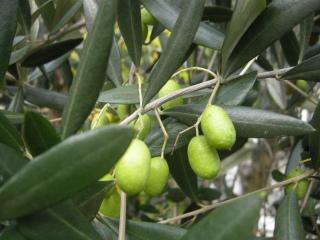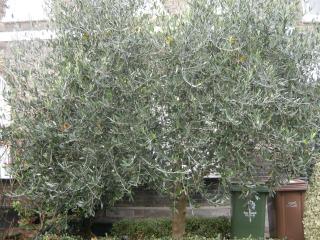
Olea europaea fruit (05/11/2011, London)
Position: Full Sun
Flowering period: Spring
Soil: Well-drained
Eventual Height: 9m
Eventual Spread: 12m
Hardiness: USDA Zones 9a – 11
Family: Oleaceae
Olea europaea is an evergreen tree with a spreading, rounded growth habit. The leaves are oblong in shape measuring 4 – 10 centimeters in length. The elliptical leaves are gray green above and silvery beneath. The flowers of the plant is white in color and are quite small. The feathery flowers are borne on last years wood, in racemes springing form the axils of the leaves. They have a ten cleft calyx and corolla, two stamens and a bifid stigma. The fruit (commonly known as the Olive) is a small drupe, 1 – 2.5 centimetres long with a thin flesh and are green to purple in color.
O. europaea, commonly known as the Olive Tree, is native to the coastal areas of the eastern Mediterranean Basin as well as northern Iran at the south end of the Caspian Sea. The olive tree is one of the plants most often cited in western literature in books such as Homer’s Odyssey. Olives today are now being looked at as a source for us as a renewable energy source. Olives are one of the most extensively cultivated fruit crops in the world. An age of 2000 years is claimed for a number of individual trees in parts of the Mediterranean. After the 16th century, the Europeans brought the olive to the New World, and it’s cultivation began in Mexico, Peru, Chile and Argentina and then in the 18th century in California. It is estimated that there are about 800 million olive trees in the world today, with the vast majority being found in Mediterranean countries. This plant is not entirely hardy in the UK and will be damaged by temperatures below -10 degrees Celsius. It is possible to gorw olive trees in containers in colder areas of the country.
The etymological root of the binomial name Olea is derived from the Latin oliva which in turn is derived from the ancient Greek elaia the name given for the Olive treee. Europaea is derived from the Latin meaning ‘of Europe’.

Olea europaea (05/11/2011, London)
The landscape architect may find Olea europaea useful as an interesting small tree for urban planting usually in domestic situations. Care should be taken when locating this tree in the UK as it may not be fully hardy, although specimens in central London seem to bee hardy.
This plant is valuable ecologically as it is attractive to birds, who eat the fruit.
Olea europaea prefers a light, well-drained soil. It will tolerate most pH of soils, although it prefers calcarious soils. It will not tolerate waterlogged soils or very dry soils.
Maintenance: This plant requires little maintenance.

